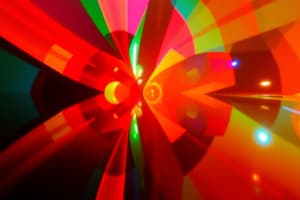Podcast
Questions and Answers
What is the essence of the law of reflection?
What is the essence of the law of reflection?
- The angle at which light strikes a surface is equal to the angle at which it rebounds. (correct)
- The angle at which light refracts is always greater than the angle of reflection.
- The angle at which light strikes a surface is equal to the angle at which it refracts.
- The incident ray, reflected ray, and the normal line are all situated in different planes.
Which law relates the angles and speeds of light as it passes through different mediums?
Which law relates the angles and speeds of light as it passes through different mediums?
- Fermat's Principle
- Law of Total Internal Reflection
- Snell's Law (correct)
- Huygens' Principle
In which scenario does light bend towards the normal line?
In which scenario does light bend towards the normal line?
- When passing from diamond to air
- When passing from air to glass (correct)
- When passing from glass to air
- When passing from water to air
Which optical phenomenon occurs when all light is reflected back into the original medium?
Which optical phenomenon occurs when all light is reflected back into the original medium?
What is the relationship between the sines of the angles of incidence and refraction, according to Snell's Law?
What is the relationship between the sines of the angles of incidence and refraction, according to Snell's Law?
What optical phenomenon is responsible for the working principles of fiber-optic cables, lasers, and some types of optical microscopy?
What optical phenomenon is responsible for the working principles of fiber-optic cables, lasers, and some types of optical microscopy?
What property of a lens allows it to converge or diverge light?
What property of a lens allows it to converge or diverge light?
Which fundamental principle governs the behavior of light when it strikes a mirror?
Which fundamental principle governs the behavior of light when it strikes a mirror?
What determines whether an image produced by a mirror is virtual, real, or magnified?
What determines whether an image produced by a mirror is virtual, real, or magnified?
Which optical phenomenon uses the principles of reflection and refraction to manipulate light?
Which optical phenomenon uses the principles of reflection and refraction to manipulate light?
Flashcards are hidden until you start studying
Study Notes
Light Reflection and Refraction: Exploring the Fundamentals
Light, the invisible yet omnipresent force that illuminates our world, follows specific rules as it bounces off and changes direction upon encountering surfaces. This article will delve into the fascinating phenomena of light reflection and refraction, which form the foundation for our understanding of vision, optics, and even our own imaging devices.
Laws of Reflection
Light behaves like a mirror-bouncing ball when it encounters a flat surface. The law of reflection asserts that the angle at which light strikes the surface ((\theta_i)) is equal to the angle at which it rebounds ((\theta_r)). This law also asserts that the incident ray, reflected ray, and the normal line to the surface (perpendicular to the surface at the point of reflection) are all situated in the same plane.
Laws of Refraction
When light passes from one medium to another, it slows down or speeds up, and its direction changes. The law of refraction can be summed up by Snell's Law, which states that the ratio of the sine of the angle of incidence ((\theta_i)) to the sine of the angle of refraction ((\theta_r)) is equal to the ratio of the speed of light in the incident medium to the speed of light in the refractive medium. In simpler terms, if light is passing from a slower medium to a faster medium, it bends away from the normal line; if passing from a faster medium to a slower medium, it bends towards the normal line.
Total Internal Reflection
In some instances, light may experience total internal reflection when it travels from a more optically dense medium (higher refractive index) to a less dense medium (lower refractive index). Total internal reflection occurs when the angle of incidence exceeds a specific threshold, known as the critical angle. This phenomenon is responsible for the working principles of fiber-optic cables, lasers, and some types of optical microscopy.
Lenses
Lenses are optical devices that use the principles of refraction to focus light. A lens is a transparent medium bounded by two surfaces, at least one of which has a spherical curvature. When light enters a lens, it bends according to the refractive index of the lens and the angle of incidence at the lens surfaces. Depending on the shape and refractive index, lenses can be made to converge or diverge light, allowing for magnification or reduction of the size of an image, respectively.
Mirrors
Like lenses, mirrors rely on the principles of reflection and refraction to manipulate light. Mirrors are reflective surfaces designed to reflect light in a specific direction, thereby producing an image. When light strikes a mirror, its reflection obeys the law of reflection, creating an image that is virtual, real, or magnified, depending on the type of mirror.
In summary, the phenomena of reflection and refraction are fundamental to our understanding of light behavior. By delving into these principles, we can develop a deeper appreciation for the workings of everyday objects such as mirrors and lenses, as well as gain insight into the foundations of electromagnetic theory and optical physics.
Studying That Suits You
Use AI to generate personalized quizzes and flashcards to suit your learning preferences.




